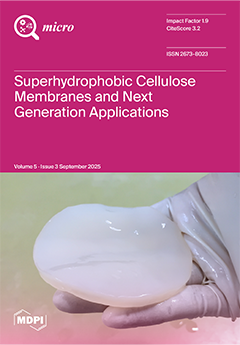Free-standing copper oxide (Cu
2O)-copper hydroxide (Cu(OH)
2) nanocomposites with enhanced catalytic and antibacterial functionalities were synthesized on copper mesh using a green method based on spinach leaf extract and glycerol. EDX, SEM, and TEM analyses confirmed the chemical composition and
[...] Read more.
Free-standing copper oxide (Cu
2O)-copper hydroxide (Cu(OH)
2) nanocomposites with enhanced catalytic and antibacterial functionalities were synthesized on copper mesh using a green method based on spinach leaf extract and glycerol. EDX, SEM, and TEM analyses confirmed the chemical composition and morphology. The resulting Cu2O-Cu(OH)
2@Cu mesh exhibited notable hydrophobicity, achieving a contact angle of 137.5° ± 0.6, and demonstrated the ability to separate thick oils, such as HD-40 engine oil, from water with a 90% separation efficiency. Concurrently, its photocatalytic performance was evaluated by the degradation of methylene blue (MB) under a weak light intensity of 5 mW/cm
2, achieving 85.5% degradation within 30 min. Although its application as a functional membrane in water treatment may raise safety concerns, the mesh showed significant antibacterial activity against both Gram-positive (
Staphylococcus aureus) and Gram-negative (
Escherichia coli) bacteria under both dark and light conditions. Using the disk diffusion method, strong bacterial inhibition was observed after 24 h of exposure in the dark. Upon visible light irradiation, bactericidal efficiency was further enhanced—by 17% for
S. aureus and 2% for
E. coli. These findings highlight the potential of the Cu
2O-Cu(OH)
2@Cu microfibers as a multifunctional membrane for industrial wastewater treatment, capable of simultaneously removing oil, degrading organic dyes, and inactivating pathogenic bacteria through photo-assisted processes.
Full article





